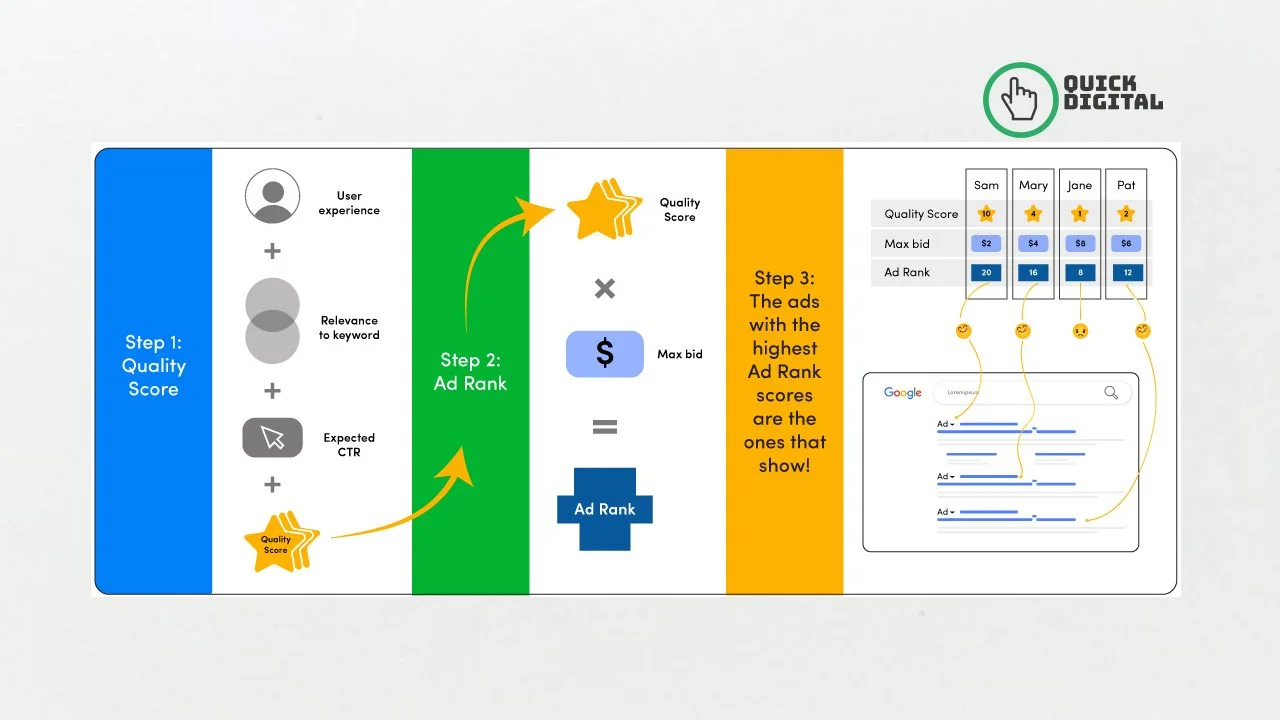
Ad Rank
There are several methods in which ads can be promoted. Some are free while some are paid. Paid ads are the most effective way of promoting an ad. The higher the audience you want your ad to reach, the higher the amount you pay. A lot of companies and business promotes their ad through pay-per-click (PPC). Through this payment, their ad will be ranked according to their numbers.
What is an Ad Rank?
Ad Rank is one of how Google grades the position of a pay-per-click (PPC) ad on a search engine results page (SERP). Ad ranking determines the position of your ad and if your ad is qualified to show up for a search. If your ad shows up first, then it means that your ad rank for that particular search is in the first position.
The position of your ad depends on the position of the keywords encompassed in your ad which will determine your ad quality score. The more important your ad keywords are, the higher your ad quality score, and your ad ranking will be. Higher ad ranking usually results in a higher exposure rate for your brand and this is because a higher ad ranking generates a lot of click-through-rates on your ad.
What is ad Rank formula?
Ad rank formula used to be simple as it was calculated using a particular formula which was “Ad Rank = Maximum Cost Per Click Bid x Quality Score.”
The formula of how Ad Rank was calculated before 2013.
However, in 2013 Google changed the formats used for Ad Rank calculations. Then, in 2017, Google Adwords introduced more important changes to how ad rank works. This introduced a very important aspect of Ad Rank which is Ad Rank thresholds and machine learning.
Ad ranking as explained by Google is “Ad Rank is calculated using your bid amount, your auction-time ad quality (including expected click-through rate, ad relevance, and landing page experience), the Ad Rank thresholds, the context of the person’s search (for example, the person’s location, device, time of the search, the nature of the search terms, the other ads and search results that show on the page, and other user signals and attributes), and the expected impact of extensions and other ad formats.”
The formula of how Ad Rank is calculated since 2017.
However, it is pertinent to note that several key factors and tips are important to improve your Ad Rank. These factors are:
1. Your maximum bid amount and ad rank thresholds.
Your maximum bid amount tells Google Ads the highest amount you are willing to pay for a single click on your ad. The maximum bid matters to Ad Rank because it is needed to bid for a particular position.
The Ad Rank threshold enables google to set minimum thresholds that your ad must attain for your ad to show. Ad Rank sets thresholds on some particular app, meaning that the deciding factor for your ad to show might be based on the content of the search.
2. Your ad and landing page quality.
This is very important to create and boost your quality score. Google Ads checks the value of your ads and the landing page linked to it. Your ad and landing page must be relevant and useful to the targeted audience.
3. The context of the user’s search.
Google calculates your Ad Rank by observing the search terms, time of the search, location of the search, nature of the search, the device type, other ads, and so on.
4. Impacts of your ad extensions and ad formats.
An ad extension is when extra information is included in your ad such as more links to certain pages on your site. Google Ads estimates how these ad extensions and other ad formats will influence your ad’s performance. This is very relevant to your Ad Rank.
Example of Ads with enabled site links.
It often assumed that bidding higher means your ad will rank higher but that is not the case when it comes to Google Adwords.
You can pay a lesser amount and yet outrank competitors who paid higher amounts if your ad is better. This is because Google wants to provide important information to searchers which would solve their problems instantly.
Just as bidding high is good, having relevance and solving searcher’s problems for searchers are more important.
Effective ways to improve your Ad Rank.
There are several ways in which you can improve your Ad Rank without spending much on click-through rates than you have to. Some of them are:
1. You have to focus on creating more useful and relevant people.
The reason why some people bid higher for their ad and still end up ranking low is that their ad is not useful and relevant enough to solve searcher’s problems fast. This is why some people who bid lower than their competitors end up ranking higher than them because the quality is very vital in Ad Rank.
As much as Google looks at the expected click-through rate of your ad, it also looks at the relevance of your ad to the search. According to Google, “When estimating the expected impact of extensions and ad formats, we consider such factors as the relevance, click-through rates, and the prominence of the extensions or formats on the search results page.”
This is why, in every ad, you need to make sure that your ad text is very relevant to the users’ search and this can only be done by understanding the users’ intent and then you mirror that intent in your PPC ad copy.
You have to start by thinking of a certain buyer and the problems they are trying to solve. Then your ads will be directed to solve this problem and to answer to their needs.
2. You have created a very specific ad group to improve your quality score.
Relevance and specificity are very important when it comes to improving your Ad Rank. Specificity can be achieved by being specific, that is, solely focusing on a particular product or service. This will lead to the success of your ad ranking.
Your ad group needs to have a specific theme and this theme needs to have important keywords that are relevant to your ad group. If one of your keywords does not align with your theme, then you’ll create an entirely different theme for that keyword.
To create more specific ad groups, you can use Single Keyword Ad Groups (SKAGs). SKAGs has the most proven track record of increasing CTRs and quality scores in just a matter of days. This is because you only have one relevant keyword per group, making it very relevant among keywords and search queries.
SKGs takes a single keyword from your ad and then breaks it down into three (3) match types. Applying these three match types (broad modifier, phrase, and exact match), you gain the advantages of specificity and wide-ranging searches while making sure that your most-searched terms get specific ads that can comprise your keyword every time without crashing. You can decide to be more specific by splitting your SKAGs into a single match type.
This is one of the simplest ways to improve your ad ranking without having to bid more.
3. Ensure a better landing page experience for searchers.
Your goal here is to deliver a positively rare landing page experience for searches. Your landing page needs to be relevant and easy to navigate. Google Ad will penalize your landing page with a lower quality score if it doesn’t provide users with a good experience.
To increase your quality score, you have to make sure your landing page is relevant to the search terms. This can be done when you take your visitors straight to the product or service your ad talks about. The copy in the ad should be compatible with the landing page contents.
Your landing page should complement your Google Ad. It should complete the advertisement and match the targeted keywords in the Google Ad. These keywords should be included in your headline, intro, and at least once in your body copy.
Your landing page should be easy to use on mobile and desktop and the page load time should be fast.
Conclusion
We have looked at the meaning of Ad rank and ways to improve you’re Ad Rank. In summary, for a better quality score and ad ranking, relevance is key as it ensures you rank better without bidding much.
Contact us for more information and consultations.





